 |
Kennedy Veterans Hospital
Memphis, TN
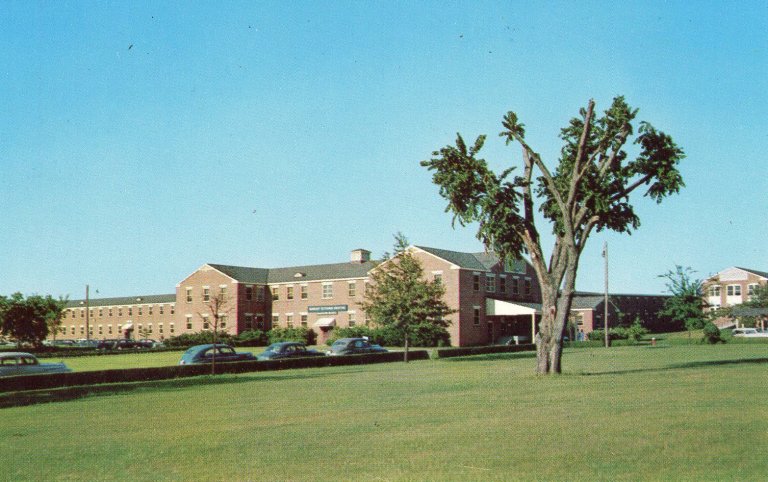
Administration Building, Kennedy General Hospital in
Memphis - ca. 1940s
courtesy eBay
The U.S. Army's Kennedy General Hospital, better known as the VA Hospital was named for Army surgeon and veteran of the Spanish-American War and World War I, Brigadier General James M. Kennedy. The 116 building state of the art facility was built
in 1942 on an over 120 acre parcel of land
at the southeast corner of Park Avenue and Shotwell, through no small part due to the influence of Memphis native and Tennessee Senator Kenneth McKellar. The efforts of Mrs. M. E. Brown from Arkansas and the Press-Scimitar
illuminated the irony of the address of a place to treat wounded
servicemen and the street name south of Park Ave. was appropriately changed
from
"Shotwell" to "Getwell" in 1942.1

Postcard of the Kennedy General Hospital Administration
Building on Getwell Rd - ca. 1940s
courtesy eBay
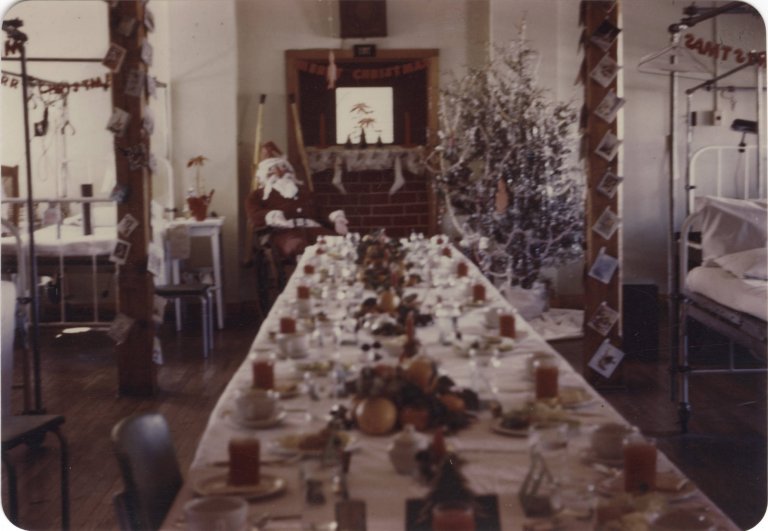
A long table set for a Christmas dinner awaits the arrival of the German POWs who are patients of Ward 2B of Kennedy General Hospital, Memphis, Tennessee, in 1945. The table is set with traditional fruit centerpieces, plates, silverware, and candles. Stockings, Christmas cards, a Christmas tree, a banner proclaiming "Merry Christmas" a paraplegic patient dressed as Santa Claus, and hospital beds can be seen in the background. |
|
Photo from Caroline Morrison Garrett
Papers, 1941-1948,
courtesy Womens Veterans Historical Project UNCG |
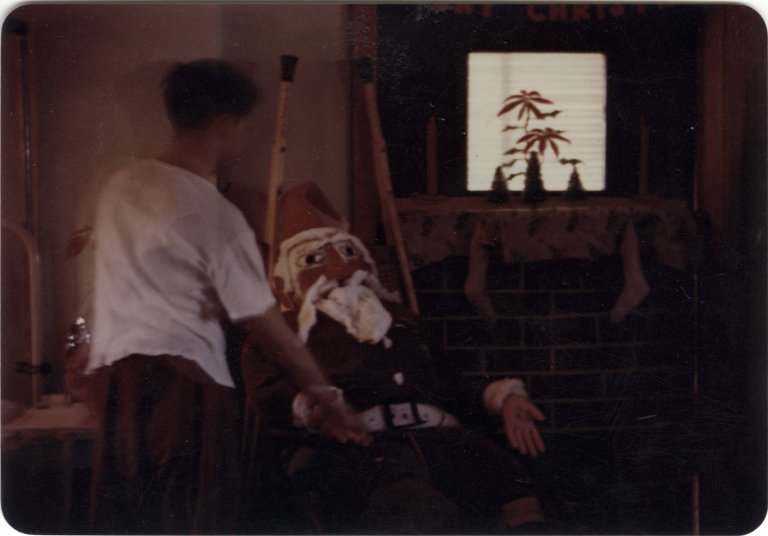
A paraplegic patient at Kennedy General Hospital in Memphis, Tennessee, is dressed as Santa Claus with a home-made mask in 1945. A large pair of crutches are behind the Santa, and Christmas stockings, candles, and a banner proclaiming "Merry Christmas" can be seen in the background. |
|
Photo from Caroline Morrison Garrett
Papers, 1941-1948,
courtesy Womens Veterans Historical Project UNCG |
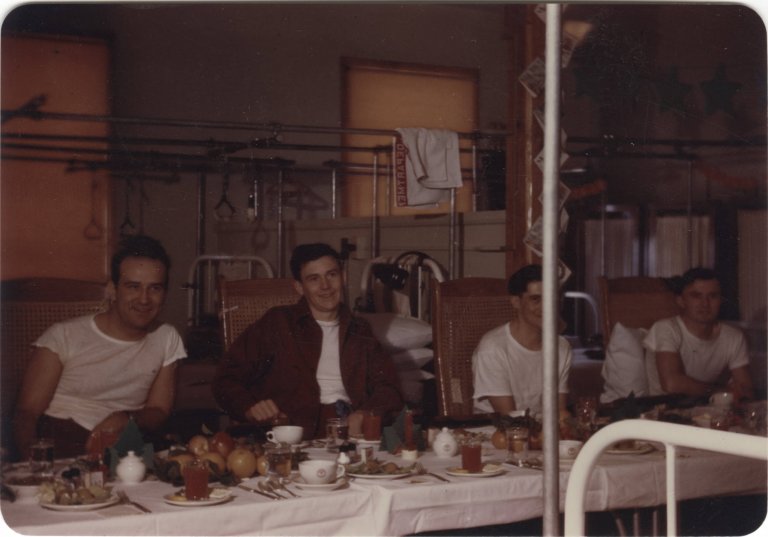
Four patients of Ward 2B of Kennedy General Hospital enjoy a Christmas dinner in 1945. The table is set with fruit centerpieces, candles, plates, silverware, and large cups. Christmas cards, and paper Christmas trees. Hospital exercise beds can be seen in the background. |
|
Photo from Caroline Morrison Garrett Papers, 1941-1948,
courtesy Womens Veterans Historical Project UNCG |
The hospital opened on January 23, 1943 to treat combat veterans of World War II
with the first wounded soldiers from overseas arriving in February -
paraplegics and quadriplegics. In July of that year, the first prisoners of war, German and Italian, began being treated at Kennedy.
Initially planned for 1500 beds the hospital had twice that and in two years it grew to be the largest Army hospital in the
country.1
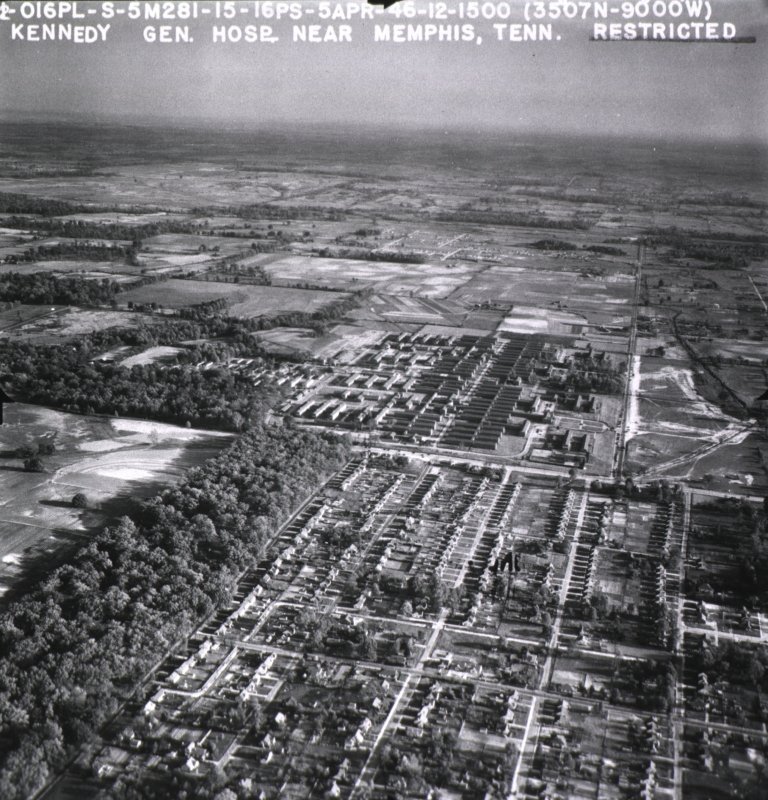 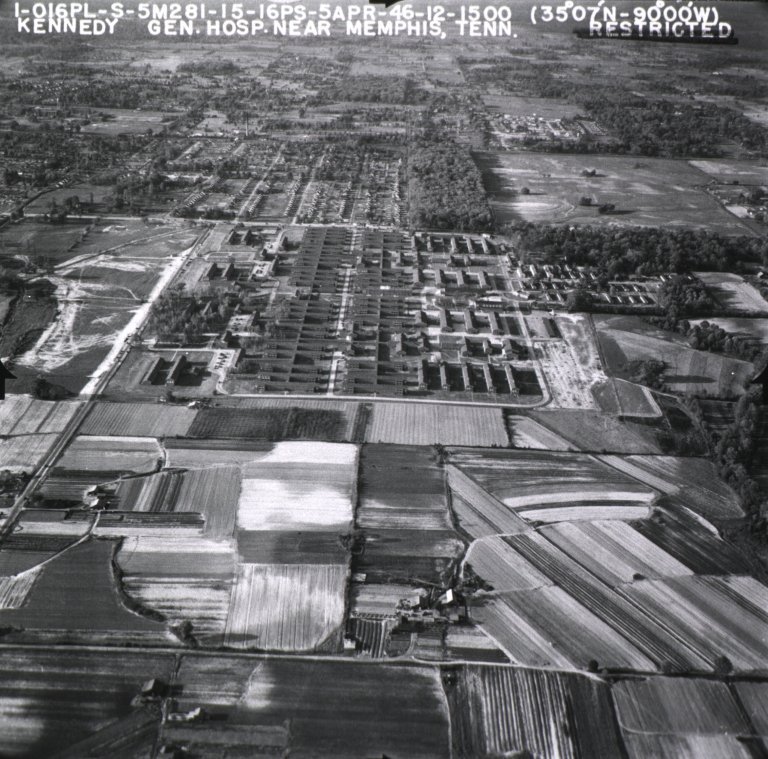
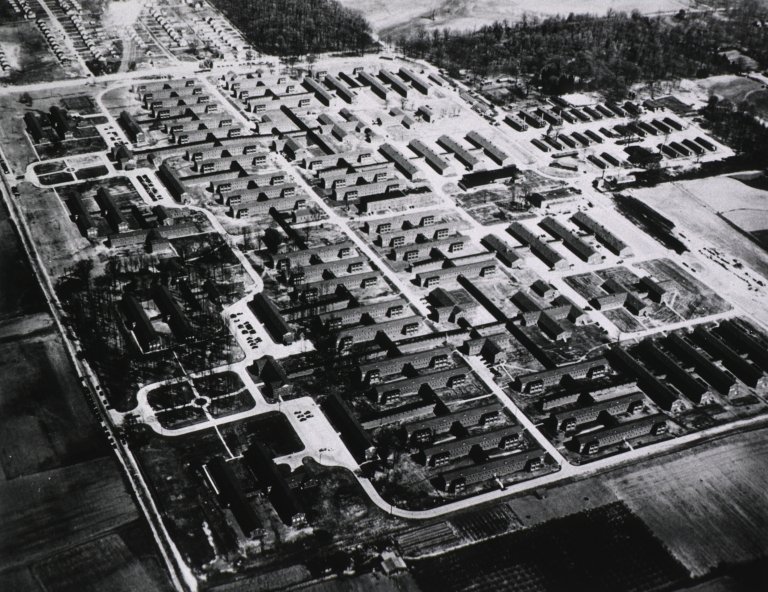
Aerials views (north and south) of U.S. Army, Kennedy
General Hospital, Memphis, TN - April 5, 1946
courtesy U.S.
National Library of Medicine
As one of the largest and best-equipped hospitals in the nation the Hospital treated all types of casualties but specialized in surgery, with an average of 30 operations a day. It had a big center for the treatment of spinal cord injuries and paraplegia and the second largest neuropsychiatry service in the
nation.2
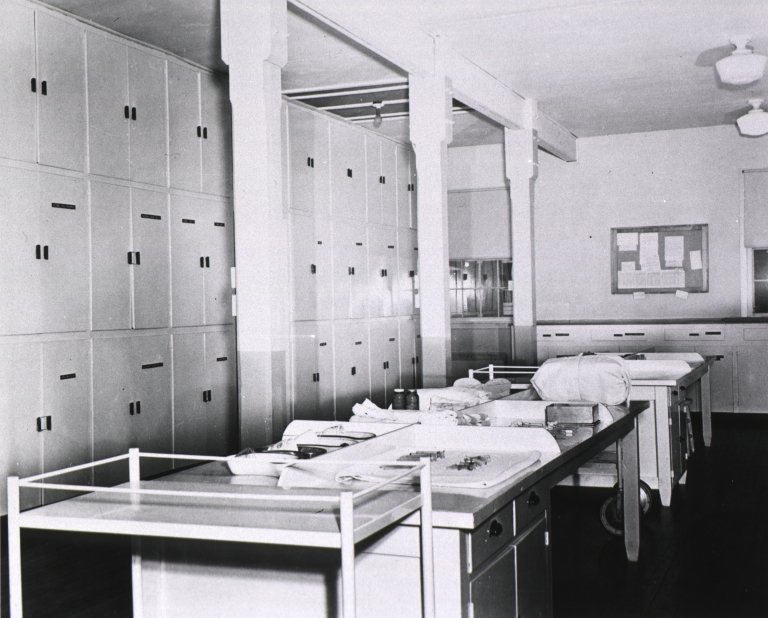 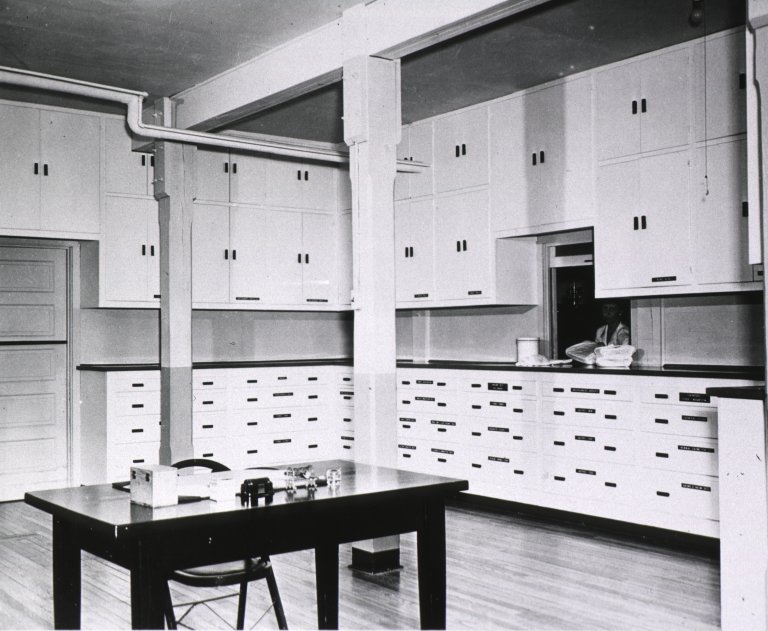
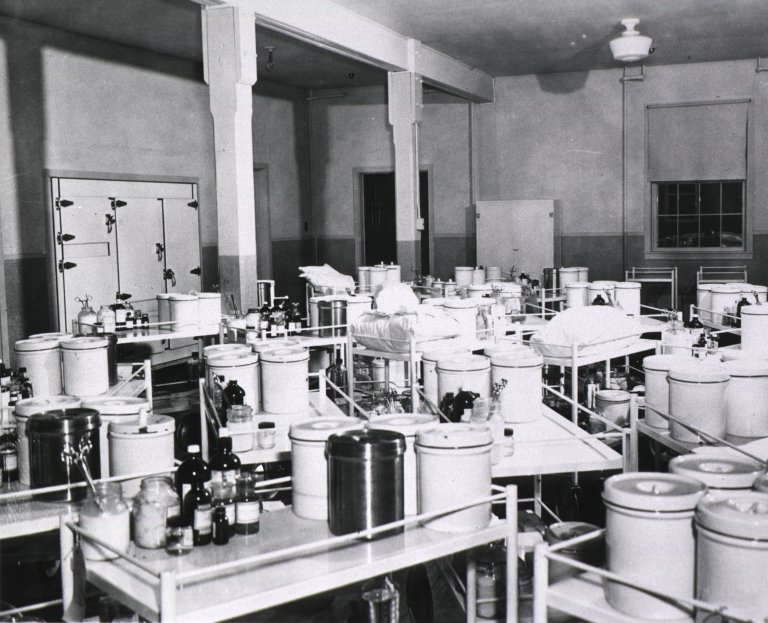
Interior views U.S. Army, Kennedy General Hospital,
Memphis, TN
courtesy U.S.
National Library of Medicine
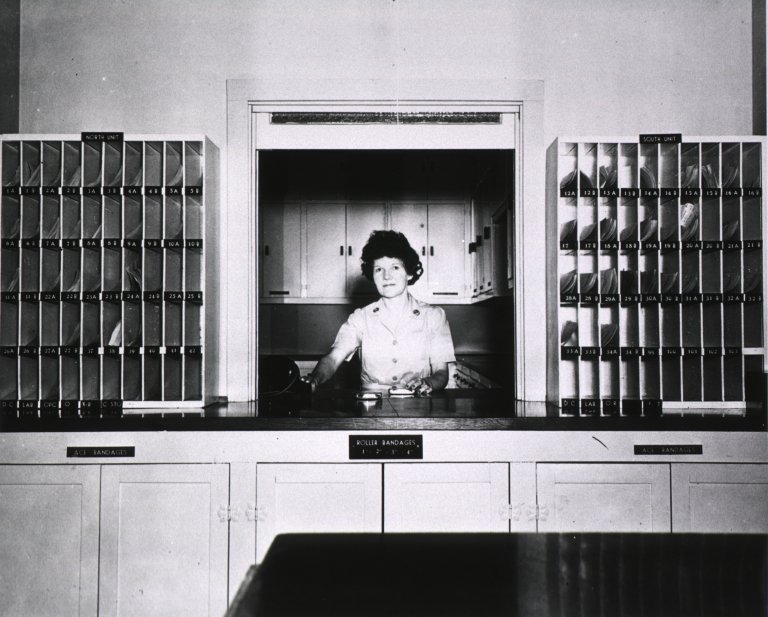
Interior view U.S. Army, Kennedy General Hospital,
Memphis, TN
courtesy U.S.
National Library of Medicine
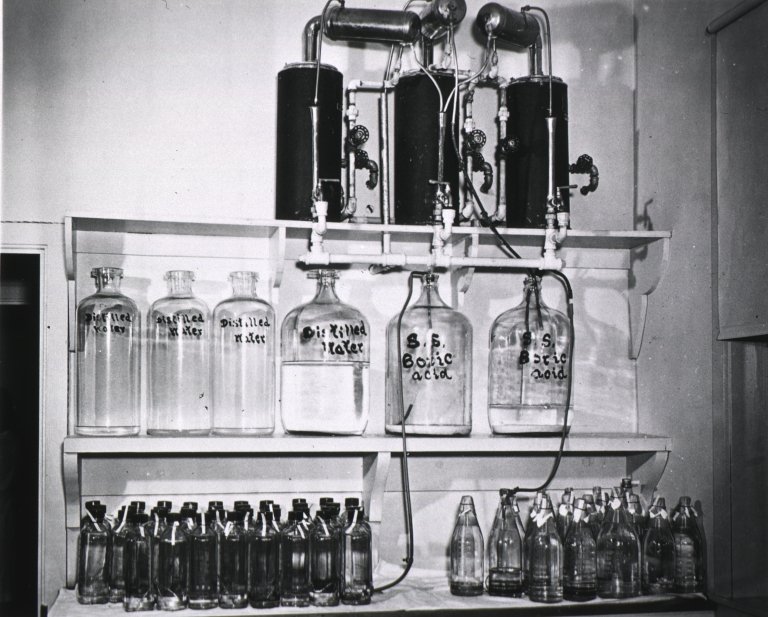
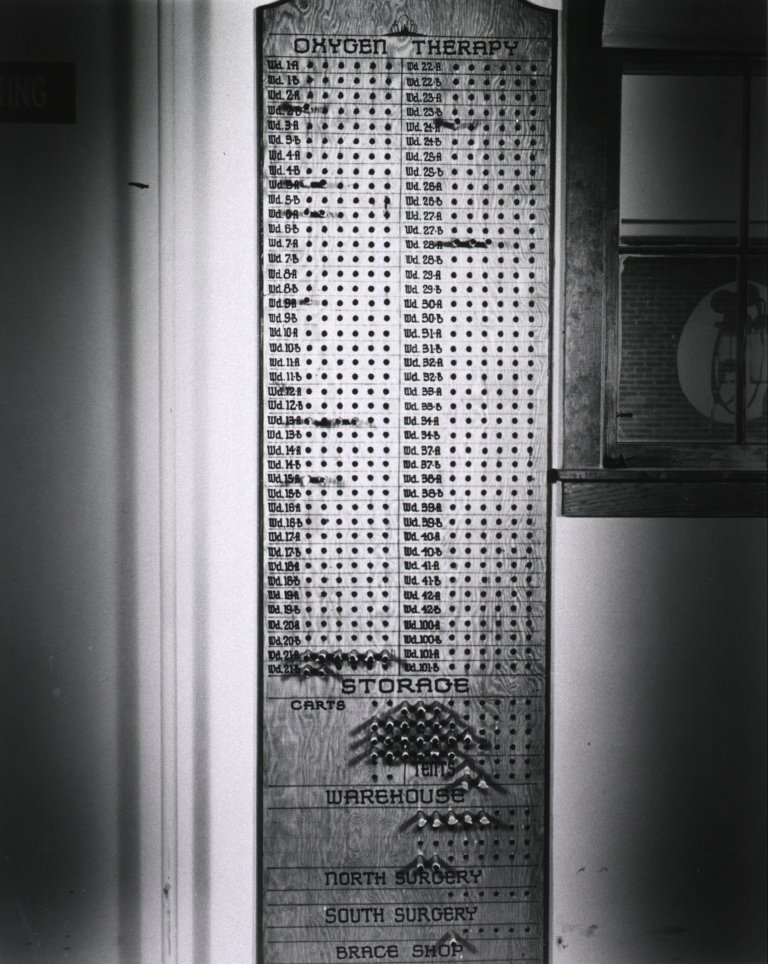 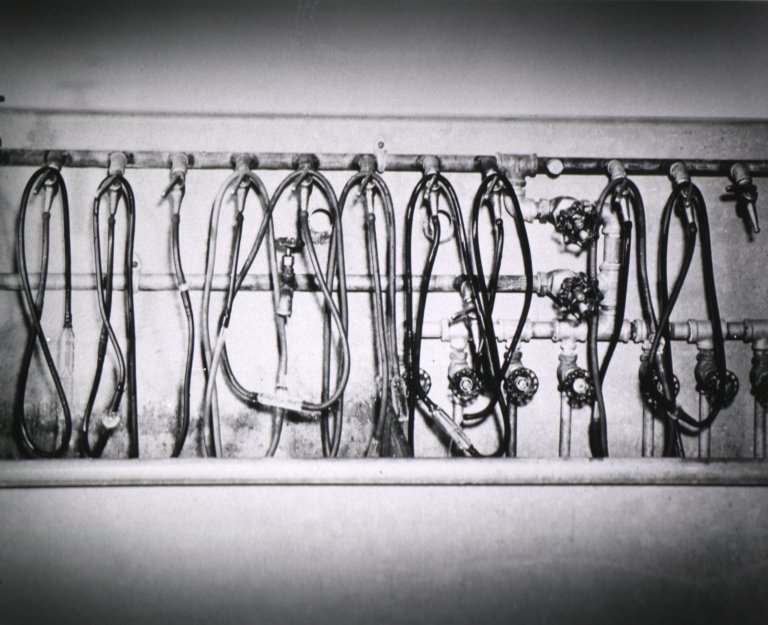
views of equipment at U.S. Army, Kennedy General Hospital,
Memphis, TN
courtesy U.S.
National Library of Medicine
One patient, James
Jones, later authored
From Here to Eternity,
the first in a World War II trilogy. He was treated for injuries received in action at Guadalcanal,
the inspiration for his The
Thin Red Line. His last novel, Whistle,
completed posthumously from tapes and notes, was the third installment
and is inspired by his experiences at Kennedy.
By the end of the war more than 44,000 combat veterans had been treated there. The Veterans Administration took ownership in
1946.1 In addition to being a pioneering medical center, the 116 building Hospital became its own, self-sustaining community with its own power station, fire department, housing for 2,000 duty personnel and most everything the staff and the patients needed: bowling alleys, a movie theater, recreation halls,
etc.2
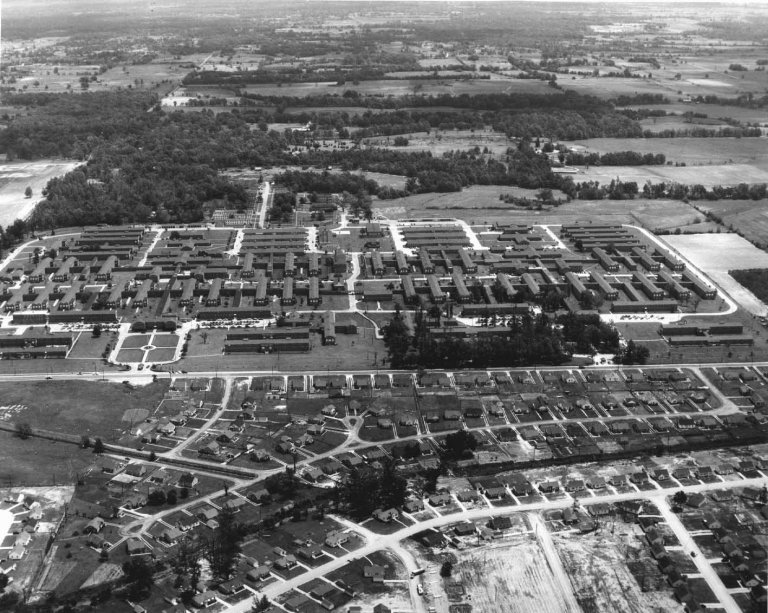
Aerial view of the Kennedy General (VA) Hospital, at
Memphis, TN (looking east across Getwell) - May 11, 1950
Photo courtesy Dept. of Conservation Photograph Collection, Tennessee
State Library and Archives
Elvis, reputedly, entertained patients at the Hospital at
times in the years before his time at Sun. According to Jerry Hopkins, Elvis' childhood
friend Buzzy Forbes said that while members of the
Odd Fellows boys club they were encouraged to participate in
charitable activities in exchange for the use of game and meeting rooms.
Buzzy said that he would dance and fool around while Elvis played his
guitar and sang when they visited patients at the Veterans hospital.3

Scotty, Doug, Bill, Millard and the Starlite Wranglers at
the Kennedy Veterans Hospital in Memphis - ca.1954
Photo originally Scotty Moore's collection
In 1954, possibly as early as 1953, Scotty got several gigs there performing for the patients with his band, the
Starlite Wranglers. When he and Bill started performing with Elvis he soon took on the role as manager and procured several dates there early on also. Peter Guralnick wrote,
Scotty took his duties as manager seriously. He and Sam agreed that it made no sense to put Elvis into some of the rough joints that Scotty and Bill had been playing, so he went looking for schoolhouses to book and local Elks Club and Lions Club events within a seventy-five-mile radius of Memphis that might be looking for a singer. He tried his hometown of Gadsden and got turned down by his old principal, who didn't think they'd make enough money to pay the light bill, but he got some dates over in Mississippi and Arkansas starting in September. In the meantime they played out at the Kennedy Veterans Hospital one Saturday afternoon and in the basement rec room of St. Mary's, across from the Courts, where they gained additional exposure if not pay. At Kennedy they played for the paraplegic and quadriplegic ward under the auspices of the
B'nai B'rith, and even there they made quite an impact, according to Monte Weiner, a classmate of Elvis' at Humes, whose mother booked the
shows.4
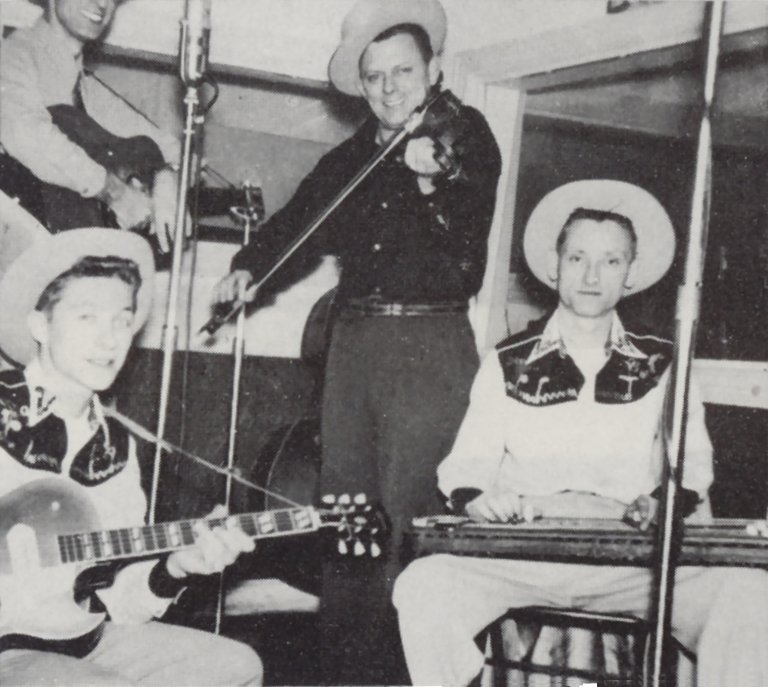
Scotty, Doug, Tommy, Millard and the Starlite Wranglers at
the Kennedy Veterans Hospital in Memphis - ca.1954
Photo originally Scotty Moore's collection
"My mother brought a group out once a month, and she knew of Elvis through me, though I didn't really know him in school. He did it for several months in a row, the first time was right after the record came out, and they'd bring people on stretchers and wheelchairs down to the little room where he was going to perform. I remember they rolled the beds out into the middle of the floor, and I watched their faces while he and his group were performing, doing something completely different from anything I had ever heard before. The patients
couldn't move at all, but their facial expressions -- it was like they were trying to clap by their facial expressions. It was a really remarkable thing,
that's all I can tell you." 4
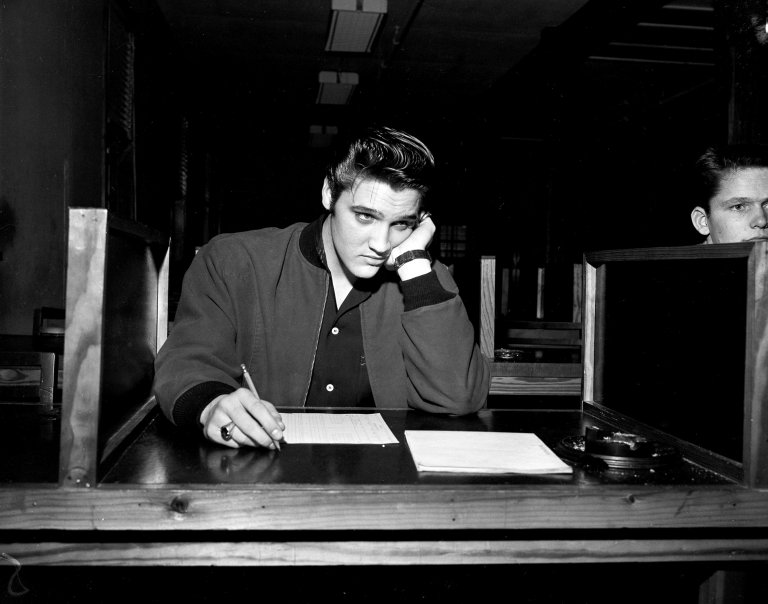
Elvis during his U.S. Army pre-induction test at Kennedy
Veterans Hospital in Memphis - Jan. 4, 1957
AP Photo courtesy Q105
Radio
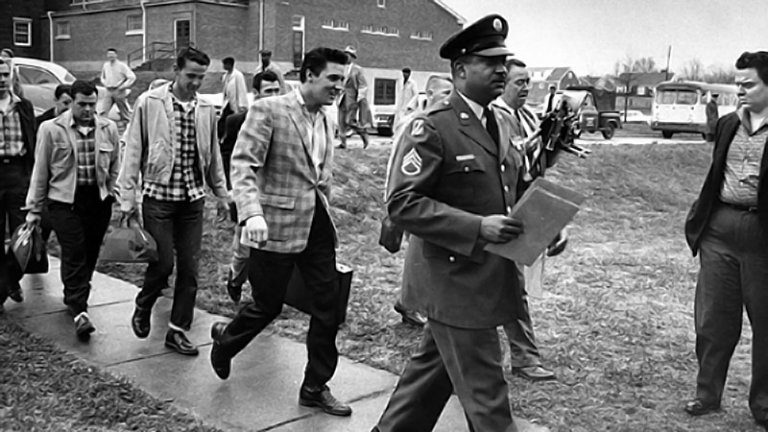
Elvis and others during induction into the Army at
Kennedy VA Hospital in Memphis - March 24, 1958
Time/Life Photo
Coincidentally, the last rented residence that the Presley's lived in (mid 1955 - mid 1956) was
a small brick house just down the street from the hospital, at 1414 Getwell
Rd*. In January of 1957 Elvis conducted his pre-induction test for the Army
as did most in that area of the country, though his draft notice
didn't come until almost a year later. In March of 1958 when he reported
for induction the hospital became the last place in Memphis he entered as a civilian until 1960.
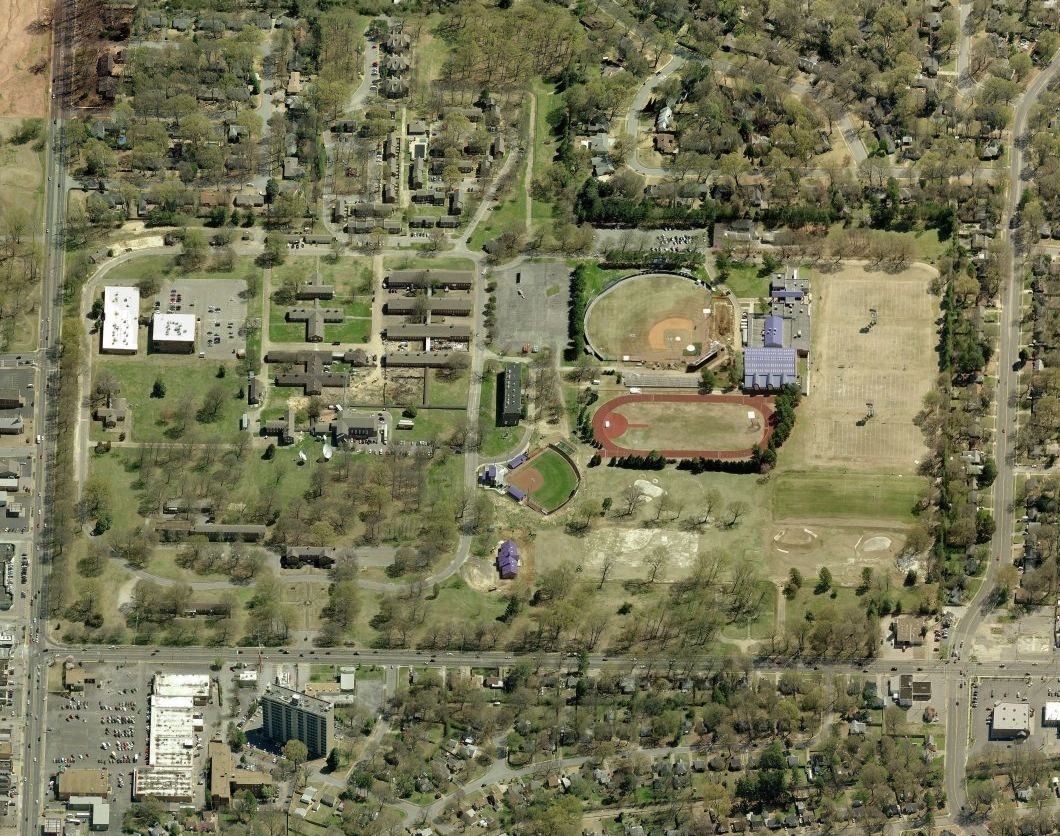
Satellite view of the MSU south campus looking east
across Getwell Rd. - ca. 2015
© Microsoft
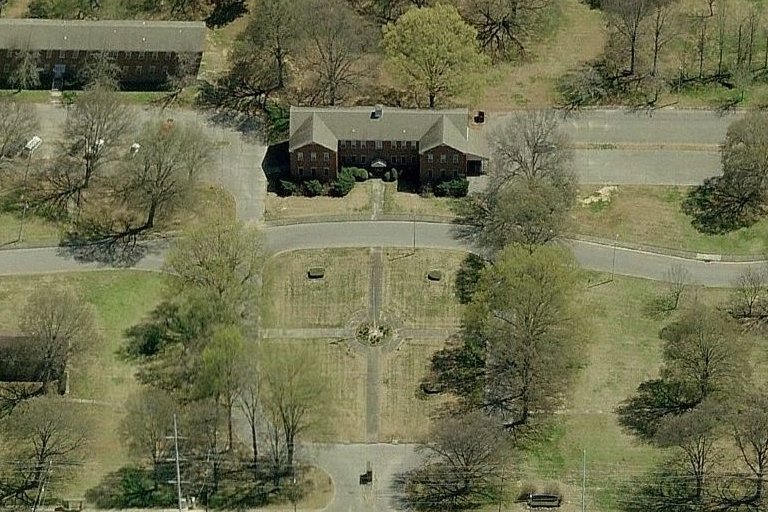
Satellite view of the former Kennedy Hospital Administration Building, at
Memphis State University - ca. 2015
© Microsoft
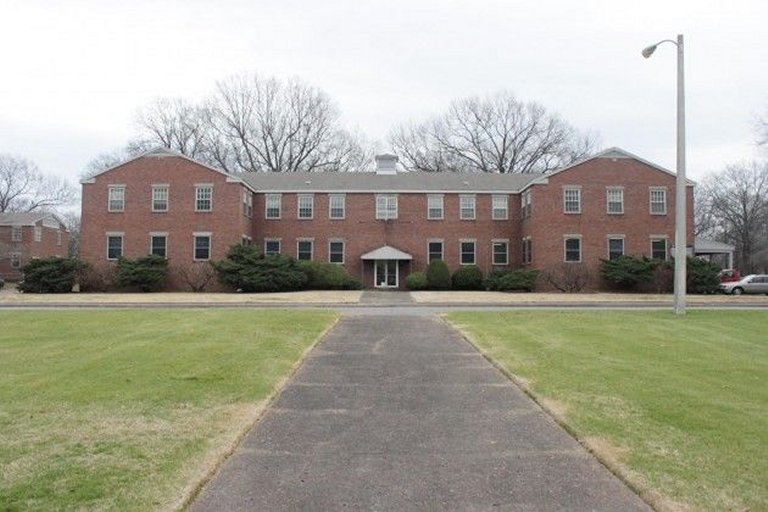
The former Kennedy Hospital Administration Building, at
Memphis State University - 2012
courtesy The
Daily Helmsman
In 1967 the hospital closed when a new VA hospital was built in Memphis.
Kennedy's land and buildings became the south campus of Memphis State University.1 Only 21 of the original buildings remain with all but one still in use.
FedEx Park, the Billy J. Murphy Track Complex, Tiger Softball Complex, Frank L. Flautt Golf Center and the Billy J. Murphy Athletic Complex are all part of the new community that resides on South
Campus.2 The site
today is denoted with a Tennessee
Historical Marker at Building 1 on the South Campus.
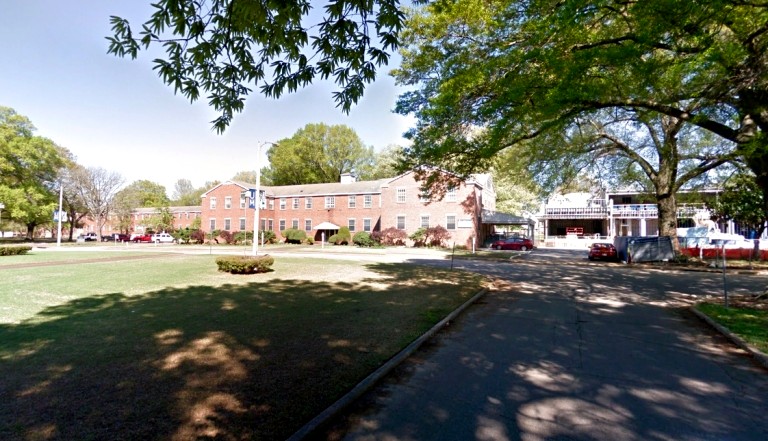
The former Kennedy Hospital Administration Building, at
Memphis State University - April 2017
© Google
1 excerpt from or according to Paul Dudenhefer and
Kennedy General Hospital: Its Impact on Memphis in War and Peace,
a 2007 dissertation by Paul White, courtesy Keyword:Memphis
2 excerpt from or according to Meagan
Nichols and/or an independent documentary for WKNO in 1999 titled "Kennedy Hospital: The City That
Cared," by Rod Starns, courtesy The
Daily Helmsman
3 excerpt from or according to Elvis:
The Biography, by Jerry Hopkins
4 excerpt from Last Train to Memphis:
The Rise of Elvis Presley, by Peter
Guralnick
* Thanks to Patricia Cockrell Hill for the correction and
description about Elvis' last rented residence. When they were
clearing the lot to build an autoparts store it was moved around the
corner to Kimball.
added August 1, 2017
Caroline Morrison Garrett
Collection Photos
remainder pertaining to Memphis
The collection includes materials created and/or used by Caroline Morrison during her time serving as a dietetic student at Woman's College of the University of North Carolina (now The University of North Carolina at Greensboro) and as a dietitian in the Army Medical Corps from 1944 through 1947. The collection also contains correspondence, educational materials and manuals, military records, newspaper clippings, photographs, pins and patches, publications, scrapbooks and an oral history transcript.
|
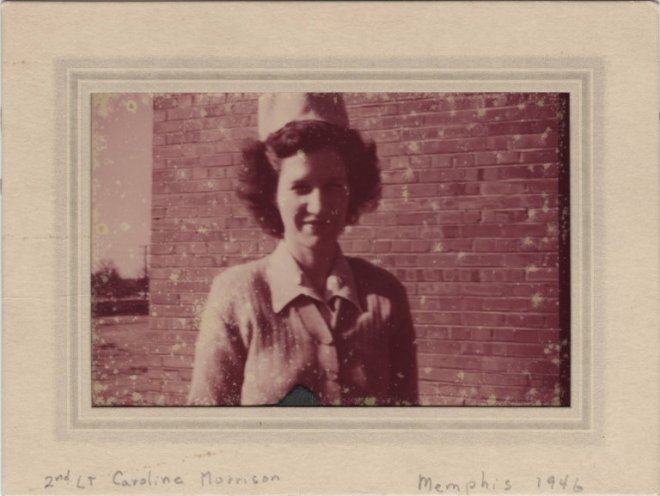
Second lieutenant Caroline Morrison Garrett is pictured in front of brick building while stationed at Kennedy General Hospital in Memphis, Tennessee, in 1946. She is wearing a white Army Nurse Corps (ANC) cap, an ANC striped seersucker hospital uniform, and an ANC cardigan style jacket over her uniform.
Photo from Caroline Morrison Garrett Papers, 1941-1948,
courtesy Womens Veterans Historical Project UNCG
|
|
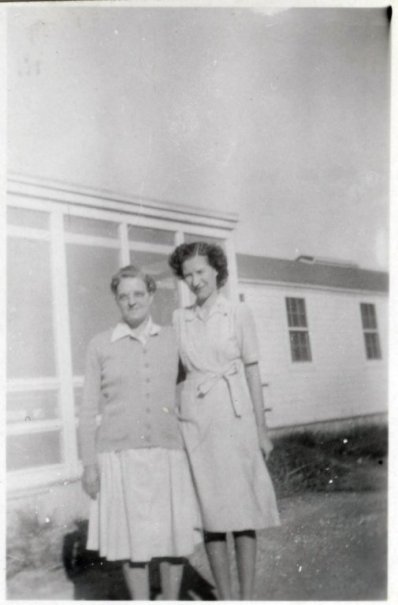
Caroline Morrison Garret (right) and an unnamed sergeant pose outside a building while stationed at Kennedy General Hospital in Memphis, Tennessee, in 1946. Caroline Morrison is wearing the army seersucker hospital uniform. The text on the back of the photograph identifies the unnamed women as:"Sgt who joined army to make up losing Farm in depression. Saw all her quarts of canned good sold at auction for 10¢ [a] quart!"
Photo from Caroline Morrison Garrett Papers, 1941-1948,
courtesy Womens Veterans Historical Project UNCG
|
|
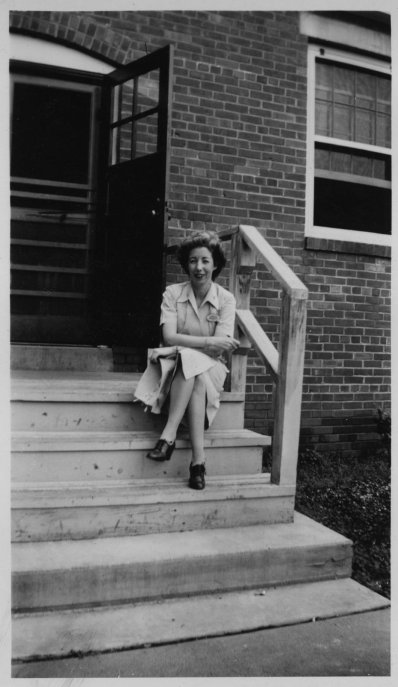
Peg Ward sits on a set of stairs outside Kennedy General Hospital in Memphis, Tennessee, in 1945. Ward is wearing a short sleeved Army Nurse Corps (ANC) hospital uniform. The text on the back of the photograph reads:"How we hated those wrap around skirts."
Photo from Caroline Morrison Garrett Papers, 1941-1948,
courtesy Womens Veterans Historical Project UNCG
|
|
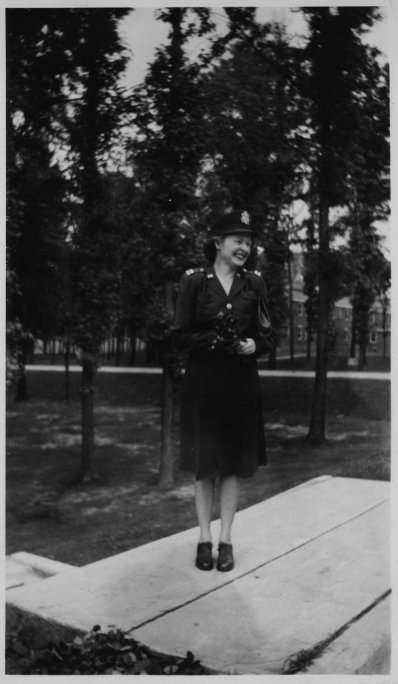
Captain Smith, the chief dietitian of Kennedy General Hospital, poses for a picture in Memphis, Tennessee, in 1946. Smith is dressed in an Army Nurse Corps (ANC) off-duty dress uniform and service cap. She has an ANC service bag tucked under her left arm.
Photo from Caroline Morrison Garrett Papers, 1941-1948,
courtesy Womens Veterans Historical Project UNCG
|
Caroline Morrison Garrett (b. 1921) of Bethel, Connecticut, served as a dietitian in the Army Medical Corps from 1944 to 1947 .
Caroline Morrison Garrett was born 10 September 1921 and raised in Bethel, Connecticut. She attended the Woman's College of the University of North Carolina (now The University of North Carolina at Greensboro) from 1941 to 1944. After graduating with a bachelor of science in Home Economics, she completed a yearlong dietetic internship and apprenticeship at Walter Reed General Hospital in Washington, D.C.
In September 1945, Garrett was commissioned as a second lieutenant into the U.S. Army Medical Corps and sent to Fort Sam Houston in San Antonio, Texas, for basic training. She was stationed briefly at Battey General Hospital in Rome, Georgia, in November 1945. She was then reassigned to Kennedy General Hospital in Memphis, Tennessee, where she primarily worked as the dietitian for the paraplegic ward through June 1946. She was then stationed at William Beaumont General Hospital in El Paso, Texas, until her discharge in August 1947, although she spent much of it on sick call from hepatitis.
Following her discharge, Garrett served as the nutritionist for families on the Floating Hospital of St. John’s Guild in New York, followed by two years as a personal assistant to a multiple sclerosis patient in Philadelphia. She also worked for two years on the private patient staff at New York Hospital- Cornell Medical Center before returning to Connecticut to work as a home representative for Connecticut Light & Power. In 1958 she married Eliot Garrett, and they lived in Pittsburg and Salt Lake City before settling in Cupertino, California.
courtesy Martha Blakeney Hodges Special Collections and University Archives, UNCG University Libraries
Dot's (Dorothy's) Photos of
several staff
at Kennedy Hospital (1940s)
collection found sold on Etsy
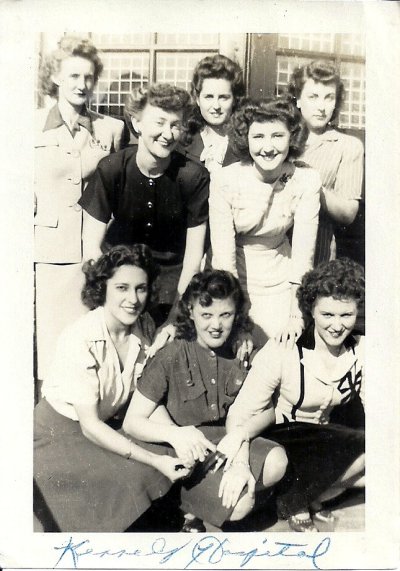
Photo courtesy Etsy
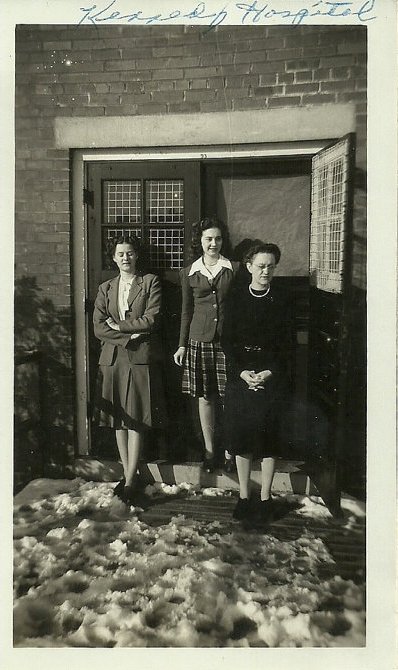
Mrs. Johnson, Bee Fite, Clarice Overton
Photo courtesy Etsy
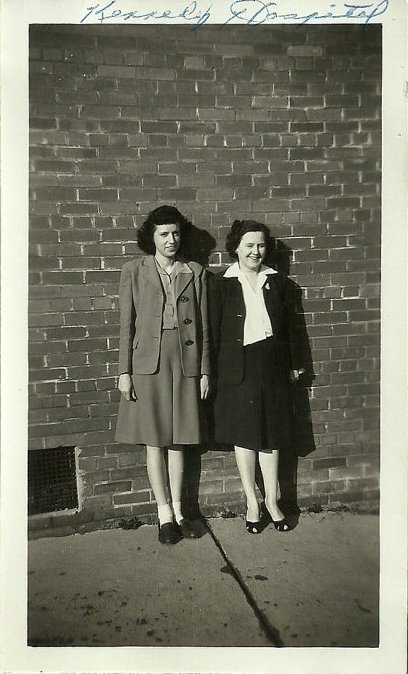
Mrs. Barry, Frances Hinsaw
Photo courtesy Etsy
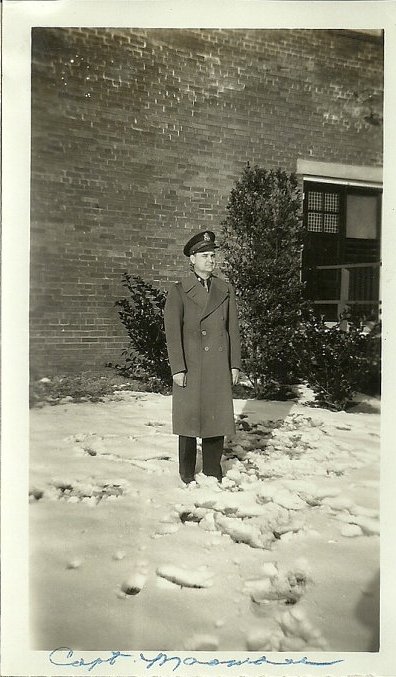
Major Moaman (not Capt.)
Photo courtesy Etsy
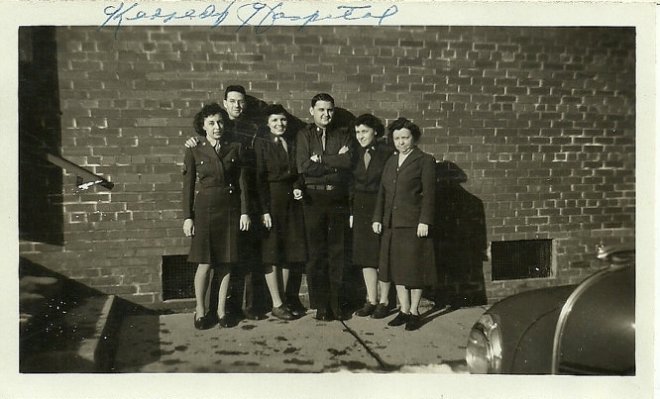
Sgt. Bader, Sgt. Lucas, Lt. Kinney, Major Moaman, Lt.
Goodrich. Miss Agnes Hern
Photo courtesy Etsy
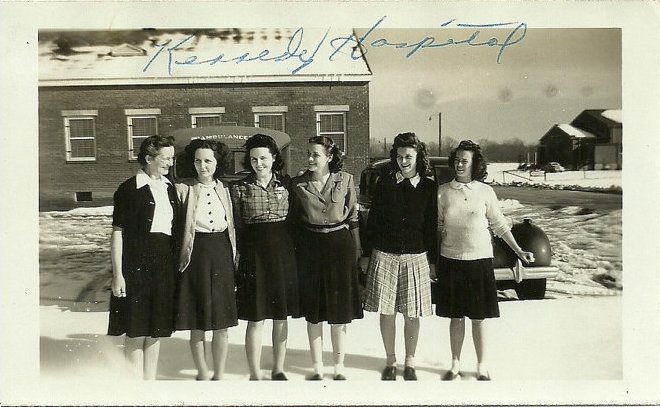
Allie,"Scottie" Scott, Elvera ?, Martha Ann
Waton, Ermie Bailey, Sarah
Photo courtesy Etsy
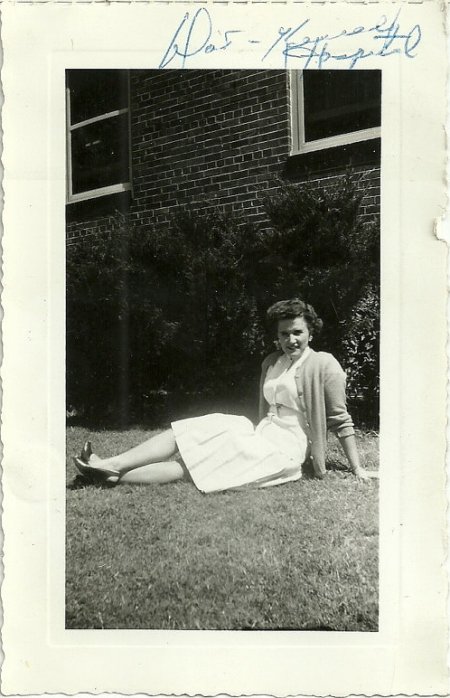
Dot
Photo courtesy Etsy
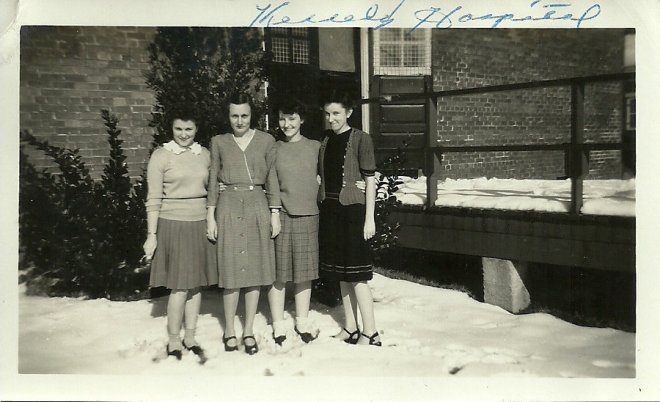
Dot, Ruth (?), Myra Dickie, Prissy Riley
Photo courtesy Etsy
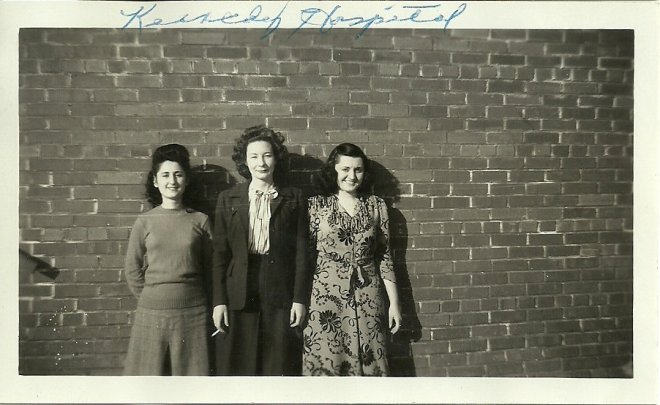
Myrtle Levitch, Lola (Bucket) ?, Rosemary McDermott
Photo courtesy Etsy
Photos captioned as best that could be deciphered.
|






































